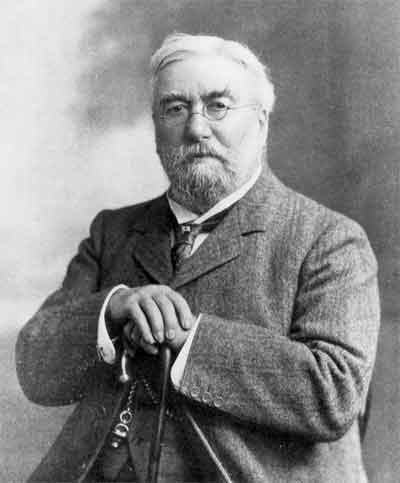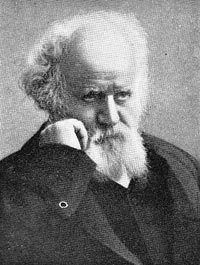<Back to Index>
- Astronomer Joseph Norman Lockyer, 1836
- Astronomer Pierre Jules César Janssen 1824
PAGE SPONSOR

Sir Joseph Norman Lockyer, FRS (17 May 1836 – 16 August 1920), known simply as Norman Lockyer, was an English scientist and astronomer. Along with the French scientist Pierre Janssen he is credited with discovering the gas helium. Lockyer also is remembered for being the founder and first editor of the influential journal Nature.
Lockyer was born in Rugby, Warwickshire. After a conventional schooling supplemented by travel in Switzerland and France, he worked for some years as a civil servant in the British War office. He settled in Wimbledon, South London, after marrying Winifred James. A keen amateur astronomer with a particular interest in the Sun, Lockyer eventually became Director of the Solar Physics Observatory in Kensington London.
In the 1860s Lockyer became fascinated by electromagnetic spectroscopy as an analytical tool for determining the composition of heavenly bodies. He conducted his research from his new home in West Hampstead, with a 6¼ inch telescope which he already used at Wimbledon. During the solar eclipse of 18 August 1868, a prominent yellow line was observed in a spectrum taken near the edge of the Sun. With a wavelength of about 588 nm, slightly less than the so-called "D" lines of sodium. the line could not be explained as due to any material known at the time, and so it was suggested by Lockyer that the yellow line was caused by an unknown solar element. He named this element helium after the Greek word 'Helios' meaning 'sun'. An observation of the new yellow line also was made by Janssen at the same eclipse, and so he and Lockyer usually are awarded joint credit for helium's discovery. Terrestrial helium was found about 10 years later by William Ramsay. In his work on the identification of helium, Lockyer collaborated with the noted chemist Edward Frankland.
To facilitate the transmission of ideas between scientific disciplines, Lockyer established the general science journal Nature in 1869. He remained its editor until shortly before his death.
Lockyer led eight expeditions to observe solar eclipses for example in 1870 to Sicily, 1871 to India and 1898 to India.
After his retirement in 1911, Lockyer established an observatory near his home in Salcombe Regis near Sidmouth, Devon. Originally known as the Hill Observatory, the site was renamed the Norman Lockyer Observatory after his death. For a time the observatory was a part of the University of Exeter, but is now owned by the East Devon District Council, and run by the Norman Lockyer Observatory Society. There is a Norman Lockyer Chair in Astrophysics at the University of Exeter named in his honor.
Lockyer died at his home in Salcombe Regis in 1920, and was buried there in the churchyard of St Peter and St Mary.

Pierre Jules César Janssen (22 February 1824 – 23 December 1907), usually known in French as Jules Janssen, was a French astronomer who, along with the English scientist Joseph Norman Lockyer, is credited with discovering the gas helium.
Janssen was born in Paris and studied mathematics and physics at the faculty of sciences. He taught at the lycée Charlemagne in 1853, and in the school of architecture 1865 – 1871, but his energies were mainly devoted to various scientific missions entrusted to him. Thus in 1857 he went to Peru in order to determine the magnetic equator; in 1861 – 1862 and 1864, he studied telluric absorption in the solar spectrum in Italy and Switzerland; in 1867 he carried out optical and magnetic experiments at the Azores; he successfully observed both transits of Venus, that of 1874 in Japan, that of 1882 at Oran in Algeria; and he took part in a long series of solar eclipse expeditions, e.g., to Trani (1867), Guntur (1868), Algiers (1870), Siam (1875), the Caroline Islands (1883) and to Alcosebre in Spain (1905). To see the eclipse of 1870 he escaped from besieged Paris in a balloon (that eclipse was obscured by cloud cover, however).
In 1868 Janssen discovered how to observe solar prominences without an eclipse. While observing the solar eclipse of August 18, 1868 at Guntur, in Andhra Pradesh, British India, he noticed a bright yellow line with a wavelength of 587.49 nm in the spectrum of the chromosphere of the Sun. This was the first observation of this particular spectral line, and one possible source for it was an element not yet discovered on the earth. Janssen was at first ridiculed since no element had ever been detected in space before being found on Earth.
On 20 October of the same year, Joseph Norman Lockyer
also observed the same yellow line in the solar spectrum and concluded
that it was caused by an unknown element, after unsuccessfully testing
to see if it were some new type of hydrogen. This was the first time a
chemical element was discovered on an extraterrestrial body before being
found on the earth. Lockyer and the English chemist Edward Frankland named the element with the Greek word for the Sun, ἥλιος (helios).
At the great Indian eclipse of 1868 that occurred in Guntur, Janssen also demonstrated the gaseous nature of the red prominences, and devised a method of observing them under ordinary daylight conditions. One main purpose of his spectroscopic inquiries was to answer the question whether the Sun contains oxygen or not. An indispensable preliminary was the virtual elimination of oxygen absorption in the Earth's atmosphere, and his bold project of establishing an observatory on the top of Mont Blanc was prompted by a perception of the advantages to be gained by reducing the thickness of air through which observations have to be made. This observatory, the foundations of which were fixed in the snow that appears to cover the summit to a depth of ten meters, was built in September 1893, and Janssen, in spite of his sixty - nine years, made the ascent and spent four days taking observations.
In 1875, Janssen was appointed director of the new astrophysical
observatory established by the French government at Meudon, and set on
foot there in 1876 the remarkable series of solar photographs collected
in his great Atlas de photographies solaires (1904). The first volume of the Annales de l'observatoire de Meudon was published by him in 1896.
In 1884 he took part in the International Meridian Conference.
Janssen died at Meudon on 23 December 1907 and was buried at Père Lachaise Cemetery in Paris. During his life he was made a Knight of the Legion of Honor and a Foreign Member of the Royal Society of London. Craters on both Mars and the moon are named in his honor.